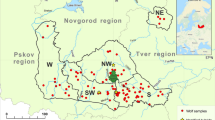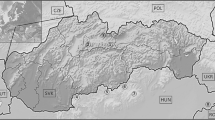Abstract
Results of previous morphometric and genetic analyses of grey wolf (Canis lupus L.) population from Serbia indicated different patterns of population subdivision. In order to explore population structure, level of genetic variability, genetic drift, inbreeding and signals of bottleneck for grey wolves from Serbia, we applied highly polymorphic genetic markers (microsatellites). Obtained data are valuable in determination of conservation units and creation of appropriate management plans. We have amplified 18 highly polymorphic microsatellites, in a total sample of 75 grey wolves, from different localities across Serbia and multilocus genotypes were analyzed using appropriate software. Observed values of the basic genetic parameters (H O = 0.69; H E = 0.75) indicated moderate level of genetic variability, similar to genetic variability in other populations belonging to the Dinaric-Balkan population of grey wolf. In STRUCTURE analysis, although ΔK was estimated to be at first peak K = 2, and second peak K = 4, CLUMPAK analyses showed that there’s no structuring for any of assumed K, and therefore the population of grey wolf from Serbia may be considered as one continuous population and treated as one conservation unit in future management plans. Signals of bottleneck haven’t been observed (Wilcoxon test two phase mutation model p = 0.247; and stepwise mutation model p = 0.815).
Similar content being viewed by others
References
Wolves: Behaviour, Ecology and Conservation, Mech, L.D. and Boitani, L., Eds., Chicago: The University of Chicago Press, 2003.
Boitani, L., Plan d’action pour la conservation du loup (Canis lupus) en Europe, 2003.
Delibes, M., Status and conservation needs of the wolf in the Council of Europe member States, Nat. Environ. Ser., 1990, vol. 47, pp. 1–46.
Randi, E., Lucchini, V., Christensen, M.F., et al., Mitochondrial DNA variability in Italian and East European wolves: detecting the consequences of small population size and hybridization, Conserv. Biol., 2000, vol. 14, pp. 464–473.
Randi, E., Genetics and conservation of wolves Canis lupus in Europe, Mamm. Rev., 2011, vol. 41, pp. 99–111.
Lucchini, V., Galov, A. and Randi, E., Evidence of genetic distinction and long-term population decline in wolves (Canis lupus) in the Italian Apennines, Mol. Ecol., 2004, vol. 13, pp. 523–536.
Gomercic, T., Sindicic, M., Galov, A., et al., High genetic variability of the grey wolf (Canis lupus L.) population from Croatia as revealed by mitochondrial DNA control region sequences, Zool. Stud., 2010, vol. 49, pp. 816–823.
Vilà, C., Walker, C., Sundqvist, A.K., et al., Combined use of maternal, paternal and bi-parental genetic markers for the identification of wolf–dog hybrids, Heredity, 2003, vol. 90, pp. 17–24.
Leonard, J.A., Vila, C. and Wayne, R.K., Legacy lost: genetic variability and population size of extirpated US grey wolves (Canis lupus), Mol. Ecol., 2005, vol. 14, pp. 9–17.
Chapron, G., Quenette, P.Y., Legendre, S. and Clobert, J., Which future for the French Pyrenean brown bear (Ursus arctos) population? An approach using stage-structured deterministic and stochastic models, C. R. Biol., 2003, vol. 326, pp. 174–182.
Nowak, S., MyslAjek, R.W., and Jedrzejewska, B., Density and demography of wolf, Canis lupus population in the western-most part of the Polish Carpathian Mountains, 1996–2003, Folia. Zool., 2011, vol. 57, pp. 392–402.
Valiere, N., Fumagalli, L., Gielly, C., et al., Long-distance wolf recolonization of France and Switzerland inferred from non-invasive genetic sampling over a period of 10 years, Anim. Conserv., 2003, vol. 6, pp. 83–92.
Salvatori, V. and Linnell, J., Report on the Conservation Status and Threats for Wolves (Canis lupus) in Europe, Council of Europe T-PVS/Inf., 2005, 16, 1–24
Aspi, J., Roininen, E., Ruokonen, M., et al., Genetic diversity, population structure, effective population size and demographic history of the Finnish wolf population, Mol. Ecol., 2006, vol. 15, pp. 1561–1576.
Kojola, I., Aspi, J., Hakala, A., et al., Dispersal in an expanding wolf population in Finland, J. Mammal., 2006, vol. 87, pp. 281–286.
Fabbri, E., Miquel, C., Lucchini, V., et al., From the Apennines to the Alps: colonization genetics of the naturally expanding Italian wolf (Canis lupus) population, Mol. Ecol., 2007, vol. 16, pp. 1661–1671.
Gula, R., Legal protection of wolves in Poland: implications for the status of the wolf population, Eur. J. Wildl. Res., 2008, vol. 54, pp. 163–170.
Chapron, G. and López-Bao, J.V., Conserving carnivores: politics in play, Science, 2014, vol. 343, pp. 1199–1200.
Hewitt, G.M., Post-glacial recolonization of European biota, Biol. J. Linn. Soc., 1999, vol. 68, pp. 87–112.
Hewitt, G.M., The genetic legacy of the Quaternary ice ages, Nature, 2000, vol. 405, pp. 907–913.
Veličković, N., Djan, M., Obreht, D., and Vapa, Lj., Population genetic structure of wild boars in the West Balkan region. Russ. J. Genet., 2012, vol. 48, pp. 859–863.
Apostolidis, A.P., Gelia, D., and Mamuris, Z., Genetic diversity among Balkan trout populations based on RAPD analysis. Russ. J. Genet., 2011, vol. 47, pp. 973–978.
Dedkova, O.S., Badaeva, E.D., Amosova, A.V., et al., Diversity and the origin of the European population of Triticum dicoccum (Schrank) Schuebl. as revealed by chromosome analyses. Russ. J. Genet., 2009, vol. 45, pp. 1082–1091.
Fabbri, E., Caniglia, R., Kusak, J., et al., Genetic structure of expanding wolf (Canis lupus) populations in Italy and Croatia, and the early steps of the recolonization of the Eastern Alps, Mamm. Biol., 2014, vol. 79, pp. 138–148.
Djan, M., Maletić, V., Trbojević, I., et al., Genetic diversity and structuring of the grey wolf population from the Central Balkans based on mitochondrial DNA variation. Mamm. Biol., 2014, vol. 79, pp. 277–282.
Milenković, M., Taxonomic—biogeographic status and ecological/economical significance of the wolf (Canis lupus Linnaeus 1758) in Yugoslavia. Ph. D. (Biol.) Dissertation, Belgrade: University of Belgrade, 1997.
Boitani, L. and Rondinini, C., In Evolution Lost: Status and Trends of the World’s Vertebrate’s, Mammalia, Baillie, J.E.M., Griffiths, J., Turvey, S.T., Loh, J., and Collen, B., Eds., 2010, ch. V, pp. 38–45.
Verardi, A., Lucchini, V., and Randi, E., Detecting introgressive hybridization between free-ranging domestic dogs and wild wolves (Canis lupus) by admixture linkage disequilibrium analysis, Mol. Ecol., 2006, vol. 15, pp. 2845–2855.
Godinho, R., Laneza, L., Blanco, J.C., et al., Genetic evidence for multiple events of hybridization between wolves and domestic dogs in the Iberian Peninsula, Mol. Ecol., 2011, vol. 20, pp. 5154–5166.
Hinrikson, M., Männil, P., Ozolinš, J., et al., Bucking the trend in wolf–dog hybridization: first evidence from Europe of hybridization between female dogs and male wolves, PLoS One, 2012, 7. e46465. doi 10.1371/journalpone.0046465
Vonholdt, B.M., Stahler, D.R., Smith, D.W., et al., The genealogy and genetic viability of reintroduced Yellowstone grey wolves, Mol. Ecol., 2013, vol. 17, pp. 252–274.
Ciucci, P., Chapron, G., Guberti, V. and Boitani, L., Estimation of mortality parameters from (biased) samples at death: are we getting the basics right in wildlife field studies? A response to Lovari et al., J. Zool., 2007, vol. 273, pp. 125–127.
Linnell, J.D.C. and Boitani, L., Building biological realism into wolf management policy: the development of the population approach in Europe, Hystrix, 2012, vol. 23. doi 10.4404/hystrix-23.1-4676
Smith, D.W., Peterson, R.O., and Houston, D.B., Yellowstone after wolves, Bioscience, 2003, vol. 53, pp. 330–340.
Duchamp, C., Boyer, J., Briaudet, P.E., et al., A dual frame survey to assess time and space-related changes of the colonizing wolf population in France, Hystrix, 2012, vol. 23, pp. 14–28.
Shafer, A.B.A., Gattepaille, L.M., Stewart, R.E.A., and Wolf, J.B.W., Demographic inferences using shortread genomic data in an approximate Bayesian computation framework: in silico evaluation of power, biases and proof of concept in Atlantic walrus, Mol. Ecol., 2015, vol. 24, pp. 328–345.
Altukhov, Yu.P. and Salmenkova, E.A., DNA polymorphism in population genetics, Russ. J. Genet., 2002, vol. 38, pp. 989–1008.
Grechko, V.V., Molecular DNA markers in phylogeny and systematics. Russ. J. Genet., 2002, vol. 38, pp. 851–868.
Schlötterer, C., Opinion: the evolution of molecular markers—just a matter of fashion?, Nat. Rev. Genet., 2004, vol. 5, pp. 63–69.
Sambrook, J.F. and Russel, D.W., Molecular Cloning: A Laboratory Manual, Cold Spring Harbor: Cold Spring Harbor Laboratory Press, 2001, 3rd ed.
Excoffier, L. and Lischer, H.E.L., Arlequin suite ver 3.5: a new series of programs to perform population genetics analyses under Linux and Windows, Mol. Ecol. Resour., 2010, vol. 10, pp. 564–567.
Belkir, K., Borsa, P., Chikhi, N., et al., Genetix 4.03 logiciel sous WindowsTM pour la genetique des populations, Montpellier: Laboratoire Genome, Populations, Interactions, CNRS UMR 5000, Univ. Montpellier II, 2001.
Weir, B.S. and Cockerham, C.C., Estimating F-statistics for the analysis of population structure, Evolution, 1984, vol. 38, pp. 1358–1370.
Pritchard, J.K., Stephens, M. and Donnelly, P., Inference of population structure using multilocus genotype data, Genetics, 2000, vol. 155, pp. 945–959.
Falush, D., Stephens, M., and Pritchard, J.K., Inference of population structure using multilocus genotype data: linked loci and correlated allele frequencies, Genetics, 2003, vol. 164, pp. 1567–1587.
Falush, D., Stephens, M., and Pritchard, J.K., Inference of population structure using multilocus genotype data: dominant markers and null allele, Mol. Ecol. Notes, 2007, vol. 7, pp. 574–578.
Hubisz, M.J., Falush, D., Stephens, M., and Pritchard, J.K., Inferring weak population structure with the assistance of sample group information, Mol. Ecol. Resour., 2009, vol. 9, pp. 1322–1332.
Earl, D. A. and Vonholdt, B.M., Structure Harvester: a website and program for visualizing structure output and implementing the Evanno method, Conserv. Genet. Resour., 2012, vol. 4, pp. 359–361.
Evanno, G., Regnaut, S., and Goudet, J., Detecting the number of clusters of individuals using the software STRUCTURE: a simulation study, Mol. Ecol., 2005, vol. 14, pp. 2611–2620.
Kopelman, N.M., Mayzel, J., Jakobsson, M., et al., Clumpak: a program for identifying clustering modes and packaging population structure inferences across K, Mol. Ecol. Resour., 2015. doi 10.1111/1755-0998.12387
Cornuet, J.M. and Luikart, G., Description and power analysis of two tests for detecting recent population bottlenecks from allele frequency data, Genet., 1996, vol. 144, pp. 2001–2014.
Luikart, G., Allendorf, F.W., Cornuet, J.M., and Sherwin, W.B., Distortion of allele frequency distributions provided a test for recent population bottlenecks, J. Hered., 1998, vol. 89, pp. 238–247.
Di Rienzo, A., Peterson, A.C., Garza, J.C., et al., Mutational processes of simple-sequence repeat loci in human populations. Proc. Acad. Sci. U.S.A., 1994, vol. 91, pp. 3166–3170.
Kimura, M. and Crow, J., The number of alleles that can be maintained in a finite population, Genet., 1964, vol. 49, pp. 725–738.
Ohta, T. and Kimura, K., The model of mutation appropriate to estimate the number of electrophoretically detectable alleles in a genetic population, Genet. Res., 1973, vol. 22, pp. 201–204.
Luikart, G. and Cornuet, J.M., Empirical evaluation of a test for identifying recently bottlenecked populations from allele frequency data, Conserv. Biol., 1996, vol. 12, pp. 228–237.
Paule, L., Bakan, J., Lavadinovic, V., and Popovic, Z., Genetic differentiation of grey wolf population (Canis lupus L.) from Balkan and Carpathians, Eur. J. Wildl. Res., 2014, vol. 1, pp. 87–93.
Hulva, P., Bolfíková, B., Ríhová, J., et al., Landscape genetics of the grey wolf in the Western Carpathian Mountains, in Migration Corridors in the Western Carpathians, 2013, pp. 4–6.
Fabbri, E., Caniglia, R., Mucci, N., et al., Comparison of single nucleotide polymorphisms and microsatellites in non-invasive genetic monitoring of a wolf population, Arch. Biol. Sci. Belgrade, 2012, vol. 64, pp. 321–335.
Milenkovic, M., Jojic Šipetic, V., Blagojevic, J., et al., Skull variation in Dinaric—Balkan and Carpathian gray wolf populations revealed by geometric morphometric approaches, J. Mamm., 2010, vol. 91, no. 2, pp. 376–386.
Pilot, M., Jedrzejewski, W., Branicki, W., et al., Ecological factors influence population genetic structure of European grey wolves, Mol. Ecol., 2006, vol. 15, pp. 4533–4553.
Saccheri, I., Wilson, I.J., Nichols, R.A., et al., Inbreeding of bottlenecked butterfly populations: estimation using the likelihood of changes in marker allele frequencies, Genetics, 1999, vol. 151, pp. 1053–1063.
Reed, J.M., Mills, J.R., Dunning, J.B., et al., Emerging issues in population viability analysis, Conserv. Biol., 2002, vol. 16, pp. 7–19.
Author information
Authors and Affiliations
Corresponding author
Additional information
The article is published in the original.
Rights and permissions
About this article
Cite this article
Ðan, M., Šnjegota, D., Veličković, N. et al. Genetic variability and population structure of grey wolf (Canis lupus) in Serbia. Russ J Genet 52, 821–827 (2016). https://doi.org/10.1134/S1022795416080044
Published:
Issue Date:
DOI: https://doi.org/10.1134/S1022795416080044




